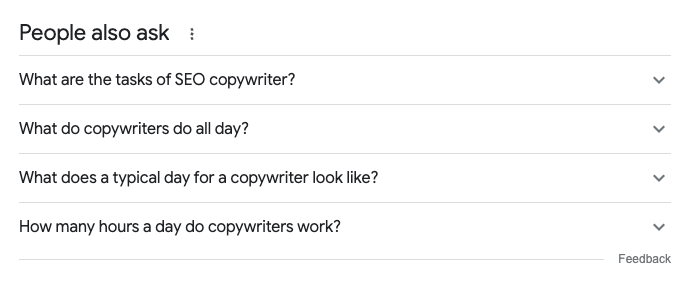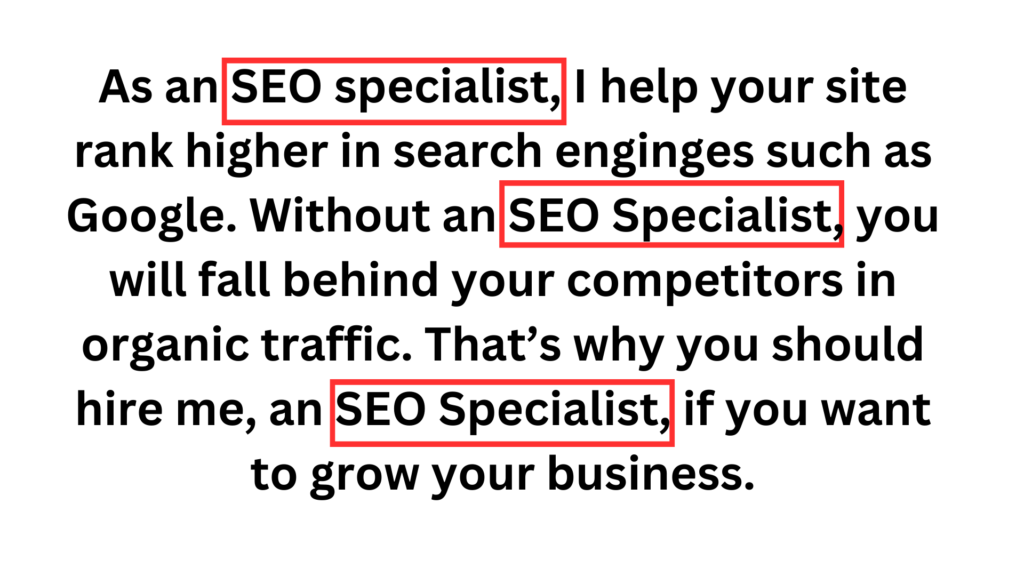I wasn’t always an expert SEO copywriter. When I first started out I made a LOT of mistakes. But the more I practised and saw what works and what doesn’t, the better I got at pleasing both people and search engine algorithms with my writing.
SEO copywriting is crucial if you want to rank high in search results. The truth is that simply by avoiding common errors, you can dramatically improve your results.
So what are the most common SEO copywriting mistakes and how can you avoid them? I’ll cover them in this article. Please note, though, these are mistakes in SEO copywriting only. If you want examples of bad direct response copywriting, check out this post instead (if you’re unsure of the difference between direct response copywriting and SEO copywriting, this post explains it).
Mistake #1: Not Doing Keyword Research
One of the most critical mistakes in SEO copywriting is not doing proper keyword research. Many people assume they know the keywords their target audience is using to find their products or services, but this may not be the case. Keyword research is essential as it helps you identify the keywords your audience is using, their search volume, and the competition for those keywords. It also enables you to identify keywords you might not be aware of so you can cover them and increase traffic to your site.
How to fix it:
To avoid this mistake, conduct keyword research before writing your content. You can use tools such as Google Keyword Planner, Ahrefs, or SEMrush to find relevant keywords. Once you have a list of keywords, use them strategically throughout your content, including in your headings, meta descriptions, and body copy.
Mistake #2: Not Using Google To Inform Your Writing
One of the biggest mistakes SEO copywriters make is not leveraging Google to inform their writing. Google provides valuable insights into what people are searching for online and what topics are relevant to your target audience. Failing to use this information can lead to content that misses the mark and doesn’t connect with your audience.
How to fix it:
To avoid this mistake, start by typing your primary keyword into Google and reviewing the suggested searches that appear. These suggestions can provide valuable insights into the topics people are searching for and the questions they have related to your primary keyword. Additionally, look at the “People also ask” section that appears on the search results page. These questions can provide ideas for content topics that your target audience is interested in. By using Google to inform your writing, you can create content that addresses the questions and concerns of your target audience, leading to higher engagement and better rankings in search engines.

Mistake #3: Not Thinking About Search Intent
Another common mistake in SEO copywriting is not considering the searcher’s intent. Search engines strive to provide their users with the most relevant results for their queries. As such, your content should address the user’s search intent, i.e., the reason behind their search.
How to fix it:
To avoid this mistake, think about the user’s intent when creating your content. Ask yourself what the user is looking for and what problem they are trying to solve. Then, create content that provides value to the user by answering their questions, solving their problems, or providing them with the information they need. If they search for ‘common SEO copywriting mistakes,’ for example, you might write a blog post that lists common errors in SEO copywriting and how to fix them.
Mistake #4: Stuffing Too Many Keywords In The Copy
Keyword stuffing is an outdated SEO tactic that involves using the same keyword multiple times in the content to rank higher in search engines. However, search engines have become smarter and can detect keyword stuffing, which can hurt your rankings.

How to fix it:
To avoid keyword stuffing, use keywords strategically throughout your content. Use them in your headings, meta descriptions, and body copy, but make sure they appear naturally and fit contextually. A general rule of thumb? Read your copy aloud and if any content containing keywords sounds unnatural, rewrite it.
Mistake #5: Writing Copy That’s Difficult To Read
Many people forget that SEO content should still be written for humans… and humans like copy that’s simple and easy to read. Poorly written content can harm your credibility and make it challenging for readers to understand your message. Ultimately, this will result in lower time on page and hurt your rankings.
How to fix it:
To avoid this mistake, write in a clear and concise manner. Use short paragraphs, bullet points, and subheadings to break up your content and make it easier to read. Additionally, use simple language and avoid jargon or technical terms that your audience may not understand. The Hemingway editor is a great tool if you want to write simpler copy, too. Make sure your content is under grade 10 and you should be OK!
Mistake #6: Believing Longer Copy Is Always Better
There is a correlation between longer content and higher rankings. However, the length of your content is not the only factor that search engines consider when ranking content. Quality and relevance are equally, if not more important. If you include irrelevant content just to increase the word count, you’re more likely to hurt your rankings than improve them.
How to fix it:
To avoid this mistake, focus on creating high-quality content that provides value to the user. Write as much as needed to cover the topic thoroughly, but don’t add unnecessary information to make the content longer. Additionally, make sure your content is relevant to your target audience and addresses their search intent. If you’re not sure where to start, take a look at the results on the first page of Google for the keyword you’re targeting. How long is the copy? Aim to write an article that’s slightly longer than those already showing (but make sure to keep all the content relevant).
Mistake #7: Not Including Keywords In Headings
Headings are essential elements of SEO copywriting, as they help search engines understand the structure of your content and the topics you cover. Not including keywords in your headings can make it harder for search engines to understand what your content is about and can hurt your rankings.
How to fix it:
To avoid this mistake, include relevant keywords in your headings, especially your H1 tag, as it carries the most weight in search engines. Additionally, use subheadings to break up your content and include keywords in those as well. Don’t go overboard, though. If every single H2 contains your keyword stuffed into it, you’ll do more harm than good. Use the keyword when it makes sense, and exclude it when it doesn’t.

Mistake #8: Not Using Synonyms For Keywords
Using the same keyword repeatedly can make your content repetitive and unengaging. However, using synonyms for your keywords can make your content more interesting and help you rank for related search terms. After all, everyone types different phrases into Google, even if the search intent is the same. For example, someone typing in ‘plumber in the Melbourne area’ likely has the same intent as someone who types in ‘Melbourne plumber.’
How to fix it:
To avoid this mistake, use synonyms and similar phrases for your keywords throughout your content. Not only can this help you show up for more keywords and phrases, but it’ll reduce the chance of keyword stuffing and make your content more readable too!
Mistake #9: Not Adding Enough Links
Links are a vital part of any on-page SEO strategy. Google will pay close attention to links pointing to, and pointing away from, every page on your website. Failing to include enough internal and external links is a common mistake.
How to fix it:
In your articles, make sure to include internal links that direct to related blog posts (or product and service pages) that readers might find useful. Also, add a mix of outbound links to other websites, especially if you’ve included stats or interesting facts from external sources.
Mistake #10: Ignoring The Big Picture
SEO copywriting is just one part of SEO… and SEO is just one area of marketing. You need to understand where both fit into your marketing and business strategy before you start investing time and money.
For example, if you’re an e-commerce store, do you know why you’re doing SEO and what the benefits of SEO are? Is SEO the best way to invest your money, or should you focus on other areas of marketing? Depending on your situation, you might actually be better off focusing on running more profitable ads, or improving your email marketing first.
How to fix it:
Make sure SEO copywriting fits in with your overall marketing and business strategy. There’s no point investing in something unless you’re educated about it first. Once you’re sure it’s the right step, take care to execute the strategy well. If you hire an SEO copywriter, connect them with your team before starting work so they’re on the same page. That way, everyone can work towards a common goal instead of getting in each other’s way.
Conclusion…
SEO copywriting is a constantly evolving field that requires a strategic approach to be successful. By avoiding these common mistakes, you’ll go a long way to writing SEO-friendly copy. It’ll make it so much easier to deliver content that resonates with your target audience and ranks well in search engines! Of course, if you want some help avoiding these mistakes because you lack the time or expertise to do it yourself, you can hire a copywriter to do your on-page SEO for you – book a free consultation here!
